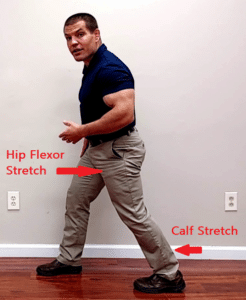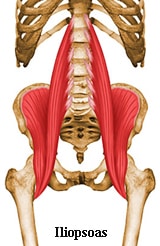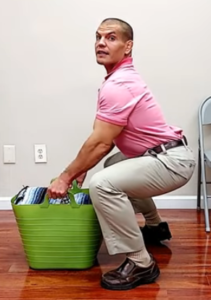Looking for daily lower body stretches that you can do in minutes per day without getting down on the floor? Try this 8-minute daily stretching routine for seniors.
Daily Stretching Exercises Need To Be Convenient
Stretching exercises are extremely beneficial for improving your mobility, and it doesn't take that much time per day to see improvements.
What it does take, though, is consistency.
As a physical therapist, I realized a long time ago that the more convenient exercises were for my patients to do, the more likely they were to actually do them.
Therefore, all of the exercises in this post can be done either seated or standing. That way you can do them just about anywhere at any time that's convenient for you.
The 4 daily stretches for seniors are:
- Standing calf and hip flexor stretch
- Seated piriformis stretch
- Seated glute / posterior hip stretch
- Seated or standing hamstring stretch
If you hold each exercise for 1 minute on each of your 2 legs, that's 8 minutes per day.
Does that sound like a reasonable daily time commitment?
If so, read on to learn how to do each of the stretches.
Standing Calf and Hip Flexor Stretch
This first exercise stretches both your calves and your hip flexors.
If I had to pick just one exercise, this would be the one.
That's because those muscle groups are the ones that are most likely to impact people when they're walking.
Calf Stretch
To do this stretch, start out in a stagger stance like this with one leg backwards and one leg.
The leg that's in back is the one that you're going to be stretching.
Start out by putting your foot on the ground with your toes pointed straight ahead. Make sure that your heels are flat on the floor. S
If your back heel is coming up, shorten your stagger a little keep it on the floor.
Then lean forwards only as far as you can without the back heel coming up off the floor.
This stretches the calf of the back leg.
Hip Flexor Stretch
Now to stretch the hip flexor at the same time, you just tuck your pelvis underneath of you.
Do a little pelvic tilt like that which flattens out your lower back. It also puts your iliacus muscles, one of your hip flexors, on a stretch.
Now hold this stretch for one minute.
Then switch legs and do the other side.
That's two minutes total - one minute on each side.
Advanced Stretches
If you want to amp the stretch up a little bit, you can put one arm up over your head and lean slightly to the other side.
This does require some degree of balance.
This version also stretches your quadratus lumborum in addition to your iliopsoas and calves.
An additional variation of this one is to stagger a little bit farther and go into a partial lunge.
This also stretches another one of your hip flexors, the rectus femoris.
Now you'll notice that your heel comes off the floor when going into this deeper lunge, so you will require extra time if you're going to do this variation.
It also requires a little bit more strength out of your front leg since you're doing a partial lunge.
So this will add to your total exercise time and it is a little bit more of an advanced version.
However, if you you just do the base version that takes you about two minutes per day if you do one minute on each side.
Seated Piriformis Stretch
The second exercise is a seated stretch for your hip rotator muscles, primarily the piriformis.
Your piriformis sits over your sciatic nerve so it can be involved in sciatica.
Being able to cross your legs is also important to put on socks or put on shoes.
To do this exercise, with with one ankle crossed over the opposite knee.
This alone may be a stretch for you.
If you need to make the stretch easier, you can straighten the other leg. Then just pull this knee up as far as you feel comfortable going.
You can also put your foot up on a couch as shown below.
Conversely, if you need to make the stretch more intense, just push the knee down on your knee using your hand.
Whichever variation you do, hold the stretch for a minute on each leg.
As your flexibility improves, you can progress through the difficulty levels.
Seated Glute / Posterior Hip Stretch
The third exercise is also going to be seated.
Just like the previous exercise, cross one leg over the other. Then pull your knee up towards your opposite shoulder.
This stretches out the the back part of your hip. This includes some of your hip rotator muscles as well as your gluteus maximus.
Bring your knee toward the opposite shoulder and then hold this for about a minute.
Then switch to the opposite side and stretch the other leg.
Seated or Standing Hamstring Stretch
The fourth exercise is going to be for your hamstrings.
I put this forth because this is probably the least necessary of the 4 stretches, but it's often the one that people are most concerned with.
Many people think they have tight hamstrings... and some people do to some extent.
However, tight hamstrings don't functionally limit you in everyday life that much.
Yes, you do need some hamstring flexibility to be able to bend down to pick something up off the floor.
However, there's also no rule saying you can't bend your knees.
Just for good measure though, here's how to stretch your hamstrings.
Standing Hamstring Stretch
You can stretch your hamstrings while standing by putting your foot up on a chair or on a couch.
Lean forward from the waist keeping your lower back straight until you feel a stretch in the back of the hamstrings.
Don't allow your lower back to round out.
An alternative variation is to sit with one leg out straight and the other leg down on the floor.
Lean forward until you feel a stretch in the back of this leg.
It's ideal to have a higher surface such as a a bed so that the leg that is down on the floor can hang down as straight as possible.
If you you're using a lower sitting surface like a couch, you can also bend the opposite knee under to stretch the quadriceps of that leg while stretching the hamstrings of the other.
This version is like a modified hurdler stretch.
Conclusion
So those were the 4 daily lower body stretches for seniors:
- Standing calf and hip flexor stretch
- Seated piriformis stretch
- Seated glute / posterior hip stretch
- Seated or standing hamstring stretch
Again, it only takes you 8 minutes per day to do all of those exercises.
Everybody has 8 minutes.
However, the great thing about seated or standing stretches is that they don't even have to be 8 consecutive minutes.
You can do two minutes while standing in the kitchen, two minutes while sitting watching TV, two minutes while sitting at the computer, etc.
You can do them just about any time anywhere.
However, flexibility is only one component of proper fitness and musculoskeletal health.
You also need adequate strength, balance, and coordination to function optimally.
If you live in the St. Louis area and need help to improve your flexibility, strength, and/or balance to that you can be more active without pain, we'd be happy to help you here at More 4 Life.
Just tap the button below to request an appointment with one of our specialist physical therapists.
Like this post? Here are some other posts about stretching exercises:
9 Chair Exercises For Seniors: Improve Flexibility With These Stretches In Only 10 Minutes Per Day
Chair Yoga Seniors Can Do For Neck Pain & Back Pain In 7 Easy Poses





















